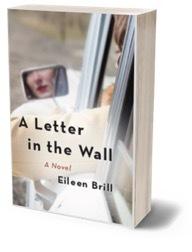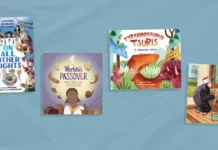
For authors, ideas for a story seem to come from thin air — a spontaneous idea, a line from a remembered conversation. For Eileen Brill, the idea for her first published novel came from a hole in her wall.
In 2007, while Brill was having some electrical work done in her Cheltenham home, the electrician pulled out a battered piece of paper from the wall in the house’s third-floor bedroom.
The electrician was about to throw it out until Brill, with a hunch, grabbed the piece of paper: a letter written on personalized stationery with the house’s address in the corner.
The Jewish author, 58 — also a writer, painter and American Sign Language interpreter — was fascinated by the letter written by a young Quaker girl and original resident of the house in the early 1930s. She spent years on-and-off researching the life and death of the young girl, Joan, realizing that the details of her life would make for a potent novel.
“There were just so many holes in her life that I couldn’t figure out, and I realized, ‘I think I have a skeleton of a really good fictionalized story here,’” Brill said.
After fifteen years of researching and writing, Brill’s story has reached the pinnacle of its life. The psychological drama and historical fiction novel, “A Letter in the Wall,” will be released by Sparkpress on May 24.
Brill is careful not to claim that her novel is about the letter’s real-life writer, but it is heavily inspired by her life and death.
The real Joan was born in 1915 to a wealthy Pennsylvania Quaker family and suffered loss at an early age when her mother died of the 1918 Spanish Influenza, precipitating the family’s move to the home in the early 1920s. Joan was also murdered in 1971 in Oklahoma City, days after she went missing, a case which remains unsolved.
Brill’s research helped to contextualize Joan’s story in a tumultuous period of American history including Prohibition and the Vietnam War, but it also exposed as many holes in Joan’s story as it sought to fill.
Sensitive to the nature of Joan’s death, Brill opted to not contact Joan’s remaining relative, her youngest daughter, now 80 years old. She did, however, meet with the archivist of Friends’ Central School, where Brill believed Joan attended. There was no record of Joan there, and no pictures found of her during the entirety of Brill’s research.
“We were looking through yearbooks, and we found the yearbook photos for her cousins and her father and her aunt,” Brill said. “In other yearbook years, there would have been the underclassman photos as well, and there were no photos of her, so that, to me, is even more creepy.”

Instead of relying on Joan’s life to guide the novel’s narrative, Brill used Joan’s voice to explore what it meant to be a young woman navigating a world before a popular feminist movement.
Joan the character is family-oriented but manipulative; she’s naive but devious all at once.
“Joan was an ordinary woman,” said Anne Dubuisson, Brill’s developmental editor for the book. “Even ‘ordinary women’, — women who are not doing those kinds of great gestures or great actions that one normally hears about in history — She’s an ordinary woman whose story still deserves to be heard.”
Susan Weinberg, a friend of Brill’s who read early drafts of the novel, found that the book mirrored many of the challenges of today. Brill gave a draft of the manuscript to Weinberg in a socially distanced drop-off in the early days of the pandemic, when unknowns about COVID stirred fear in so many, not unlike Joan’s experiences surviving a pandemic a century prior.
“I’m reading about this woman who, in 1917, had the same experience in what was going on,” Weinberg said.
Though “A Letter in the Wall” is commentary on feminism and history through the lens of an author in the 21st century, Brill was careful not to project too much of herself into the book. A secular Jew married to the son of Holocaust survivors, Brill decided against having any Jewish characters in her book, despite early readers questioning the decision.
“I was really aware that there were no Jewish characters in my book,” Brill said. “My character wasn’t interacting — Jews weren’t part of her world.”
Joan was written by a Jewish author, however, and her story is intertwined with Jewish values Brill learned growing up.
“The whole slant of my story has a lot of empathy in it, which I think is also [in] my Jewish background, and caring about others, viewing others through that lens,” Brill said.
Brill will hold a signing for “A Letter in the Wall” at the Rittenhouse Square Barnes & Noble on June 4 at 4 p.m.






